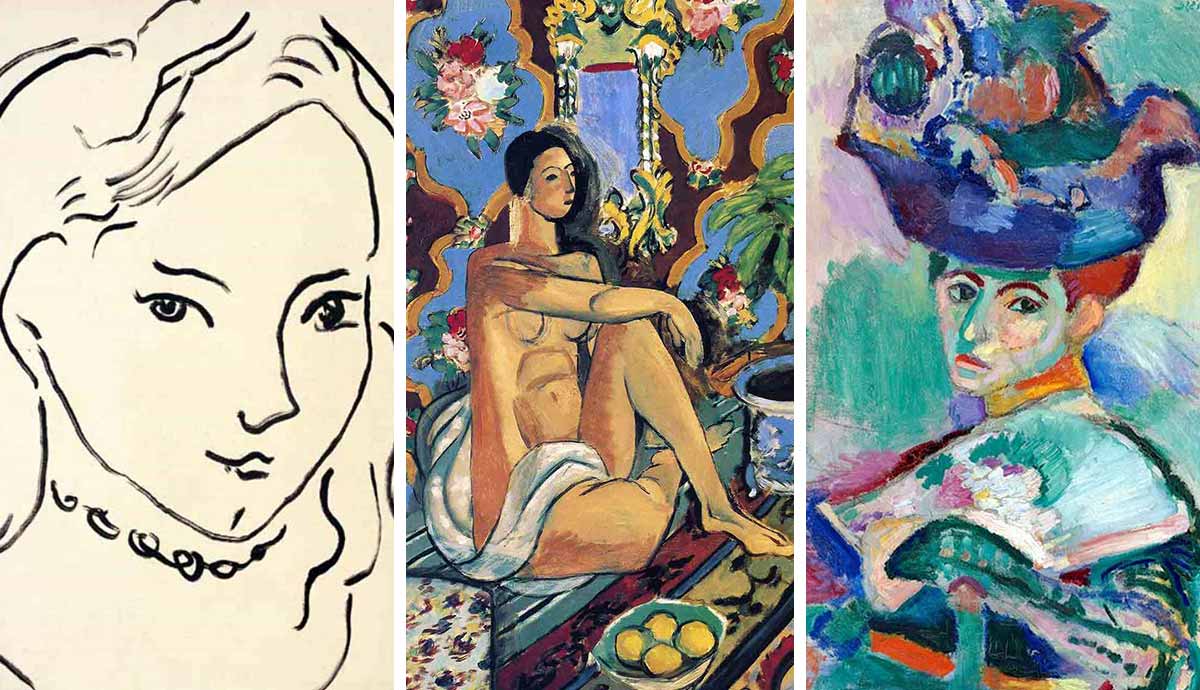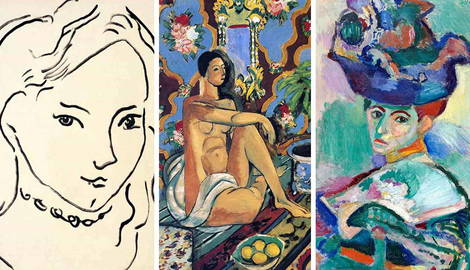
The fact that Henri Matisse had a child with one of his models and then married another one stirs any art enthusiast’s curiosity. How would one define the relationship between them? How did they work together? How did the painter choose his models? What impact did the models of Henri Matisse have on his art? Art historians have attempted to outline a plausible answer to these questions, which helps us put some pieces together. One thing is certain though, Amélie Matisse and Lydia Delectorskaya were pivotal for Henri Matisse’s career.
1. Camille Joblaud: One of the First Models of Henri Matisse

Henri Matisse met Camille Joublaud in 1892 when she started posing for him and George Lorgeoux. Lorgeoux was the one who taught Henri Matisse how to make sculptures. At that time, Matisse was working on clay medallions with Joblaud’s profile on them.
Camille went on to pose for Matisse frequently, and the two of them often traveled together, enjoying their youth as much as possible—considering that neither had too much money to spare for pleasure. Henri and Camille were not married though. This took a toll on their relationship when they found out that Camille was pregnant with their soon-to-be-born Marguerite. Nonetheless, their relationship went on. Matisse would later legally acknowledge Marguerite as his daughter, as did Matisse’s parents, even though this was considered outrageous at the time.

Over the years, the relationship between Matisse and Camille faded because he always put his career before his romantic life. The two eventually parted ways. When examining all of Matisse’s works in chronological order, you can easily notice the time when the couple broke up because Camille stopped posing for him.
Despite their break up, Camille played an important role in Matisse’s growth as an artist. She stood by him in all those uncertain years during which he was not sure whether he had what it took to become a successful painter. One of Matisse’s most iconic paintings Camille Joublaud modeled for is Woman Reading, an early painting made in 1895 when the artist was slowly transitioning toward the discovery of vivid color and light.
2. Cesar Pignatelli, aka Bevilacqua

By the time Cesar Pignatelli posed for Henri Matisse, he was already known as Auguste Rodin’s favorite model, having posed for him for twenty years. Auguste Rodin was a famous French sculptor, and Pignatelli was the model behind his iconic St. John the Baptist Preaching and The Walking Man.
Pignatelli first posed for Matisse in 1900. The painter was so impressed with the model that he produced over a hundred drawings of him over the next several years. One of Matisse’s most famous sculptures, The Serf, was modeled after Cesar Pignatelli.
Rodin and Matisse saw the model as “a man of nature, a visionary, a believer, a precursor who came to announce one greater than himself.” Rodin also said: “The peasant undressed, climbed onto the revolving stand as if he had never posed before; he planted himself firmly on his feet, head up, torso straight, at the same time putting his weight on both legs, open like a compass.”
3. Marguerite Matisse

Marguerite, the daughter of Camille Joblaud and Henri Matisse, was one of the artist’s favorite models. Although he and her mother separated when Marguerite was only a child, Matisse loved his daughter tremendously and spent time with her whenever he could. Camille had trouble finding a job as a single mother, so she agreed to let Amélie, Matisse’s new wife, raise her as her own. Although this seems like a cruel decision, Marguerite couldn’t be happier in her new home where she was surrounded by love and affection. The relationship between Marguerite and her father grew increasingly stronger and more affectionate.
Eventually, Marguerite became his favorite model and was always depicted with a ribbon around her neck. When she was six years old, poor Marguerite had to undergo a tracheostomy procedure after she had trouble breathing. Doctors cut a hole in her neck to allow her to breathe. Since then, she always wore a ribbon around her neck. Until her father’s death, Marguerite was his model, critic, and assistant. She also devoted herself to cataloging her father’s work after his death.
4. Amélie Matisse

Amélie Noellie Parayre and Henri Matisse married in 1898, just a few months after meeting. She was exactly what Matisse was looking for—a woman who would love his art as much as she loved him. Over the long time they spent together, she was his rock and his muse. She made sure Matisse had everything he needed to channel his creativity. Sometimes, when Matisse was tormented by insomnia and frustration, Amélie would spend nights reading to him. She was also the one always making sure that the kids never bothered their father when he was working.
Amélie was very happy with her duties in the family. She remained by her husband’s side during the darkest times of his career, when his art was laughed at and mocked. She was the model behind some of Matisse’s most disturbing and controversial pieces. These include Woman with a Hat, one of Matisse’s best-known paintings. It prompted the critic Louis Vauxcelles to use the words Les Fauves (wild beasts) to describe Matisse’s paintings. Woman with a Hat is executed in loose, visible brushstrokes and vivid colors that do not correspond with reality. At the time, painting a woman’s face or body in such colors was considered outrageous.

Another controversial work Amélie modeled for is The Green Stripe, named after the green line dividing her face. By using this unconventional color to outline shadows, Matisse tried to convey a specific mood and emotion. After all, the main goal of Fauvist artists was to base their work on feelings and observations rather than scientific theory.
At the beginning of their marriage, Amélie spent much time posing for her husband. When they traveled, the two often looked for secluded spots in the open air where she could pose nude without the curious looks of the passers-by. Over the years, however, Amélie started posing less frequently. She devoted her life to his art and when his assistant Lydia Delectorskaya started filling her duties in this regard, Amélie decided to leave Matisse and never pose for him again.
5. Rosa Arpino

Rosa Arpino was the model for one of Matisse’s most revolutionary paintings called The Joy of Life. In 1905, when Henri Matisse started working on this piece, Rosa Arpino was only 18 years old. The Joy of Life is a composition made up of independent motifs that shock with unconventional perspectives and weird proportions. Rosa modeled for all the female figures seen in this work. She had large black eyes and a supple body which made her a favorite of the Fauvist artists. Between 1905 and 1907, she was constantly present in their paintings.
She also became close with the rest of the Matisses. She traveled with them to Collioure, where she would model for the young painter on multiple occasions. Over the years, Rosa lost contact with Matisse. She got married and became the mother of three children. After her husband died in the war, she contacted the painter to ask if he was looking for any models, but he ended up working with her sister, Loreta.
6. Henriette Darricarrère

Henriette Darricarrère was one of the few models Matisse was truly fascinated with. She posed for him for seven years, from 1920 until 1927. The Matisses saw Henriette as another daughter. She was very close with Marguerite and they often posed together for Matisse. Amelie, Matisse’s wife, grew very fond of Henriette as well. The artist even offered Henriette painting lessons and supported her ambitions to succeed in becoming a dancer and musician.
Henriette posed primarily for Matisse’s famous odalisques, which were and still are the subject of much controversy, considering the political, social, cultural, and sexual implications. The exploration of this theme culminated with Decorative Figure on an Ornamental Ground in 1926. It was, at the time, as controversial as his earlier works had been in the 1910s.
7. Lydia Delectorskaya: The Last Model of Henri Matisse

Lydia Delectorskaya was born in Siberia. She was raised by an aunt with whom she moved to France, seeking a better life. In 1932, Lydia was divorced, penniless, and half-starved when she met the Matisses who offered her a job as a studio assistant. The family took Lydia under their wing, feeding and supporting her. Two years later, she moved in with them.
After a while, Lydia started posing for Matisse. Amelie, Matisse’s wife, was truly fond of Lydia, at least initially. Over the years, as Amelie’s health declined, so Lydia took on more and more responsibilities around the house. This alarmed Amélie, who had devoted her whole life to supporting her husband’s career. She sacrificed her own little pleasures to ensure he had the means and time to paint. People usually focus on finding out whether Matisse and Delectorskaya were in a romantic relationship. Amélie, however, felt betrayed in a completely different way.

Amélie made Matisse choose between her and Lydia, so the model eventually had to leave their house. In the end, Amélie decided to get a divorce anyway. In the meantime, Lydia Delectorskaya, having lost the last thing she cared for, tried to kill herself. Around the beginning of World War II, Matisse asked her to return to work as his assistant. Lydia remained at his side until his death, claiming there was never a romantic relationship between them. She posed for more than 100 drawings and sketches and at least 90 paintings signed by Matisse, including Blue Eyes.










